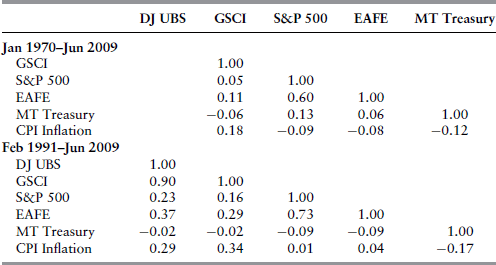PERFORMANCE IN A PORTFOLIO
Commodities are a true alternative investment. Not only do they offer returns varying widely over time relative to stocks, but their correlations with stocks and bonds are low. Consider the correlations reported in Table 12.4 between the Goldman Sachs and Dow Jones-UBS commodity indexes on the one hand, and stock and bond indexes on the other hand. The table gives correlations for two periods, one beginning in 1970 and the second beginning in 1991 (when the DJ UBS commodity index begins). Commodities have low correlation with stocks and bonds, particularly in the longer period. From 1970 to 2009, the correlation between the Goldman Sachs index and the S&P 500 is only 0.05 and the correlation with the EAFE index is only 0.11.7 For the shorter period beginning in 1991, the correlations are a little higher between commodities and stocks. For example, the correlation between the DJ UBS index and the S&P 500 is 0.23, and the correlation between the Goldman Sachs index and the S&P 500 is 0.16. The correlation between commodities and bonds is low in both periods.
TABLE 12.4 Correlations between Commodities and Other Assets
Data Sources: S&P, Dow-Jones-UBS Commodity Indexes©, ©Morningstar, MSCI, and IMF.

One other correlation is of particular interest, the correlation between commodity futures and inflation. To be a good hedge against inflation, commodities must ...
Get Portfolio Design: A Modern Approach to Asset Allocation now with the O’Reilly learning platform.
O’Reilly members experience books, live events, courses curated by job role, and more from O’Reilly and nearly 200 top publishers.

